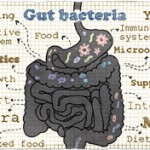
Elena Elisseeva/shutterstock.com
SAN FRANCISCO—The organisms in the gut are remarkably malleable with diet, dangling the possibility that diseases could potentially be affected by the food that people eat, according to an expert here at the 2015 ACR/ARHP Annual Meeting.
Diet
Starting with studies of animal feces from zoos and from the wild, in which researchers found that the driving force behind their microbiome was their diet, investigators have now zoomed in to find the types of organisms that flourish in which kinds of diets, and how those communities of organisms change when the diet changes, said Peter Turnbaugh, PhD, assistant professor of microbiology and immunology at the University of California San Francisco.
His lab found, in human studies, that the changes are particularly dramatic during the consumption of an animal-based diet relative to a plant-based diet, with bacteria tolerant to bile acids becoming elevated.1

Dr. Turnbaugh
“This, we thought, was very intriguing,” Dr. Turnbaugh said. “It’s well known that if you eat a very high-fat diet, it causes your body to release more bile acids into the gut. And that can have an antimicrobial effect against many different bacteria.”
At the same time, bacteria good at degrading plant polysaccharides became less abundant.
“And so one hypothesis might be that we’ve taken away the fiber from the diet, and now these groups are starving,” he said.
There are reasons to think that these changes can have real effects on disease. A paper in 2012 showed that in mice with a diet high in certain types of saturated fat, there is an increase in the release of bile acids, with an accompanying increase in bacteria including Bilophila wadsworthia.2 And in the right genetic context, this microbe can drive inflammatory bowel disease.
In his experiments, the group that was most elevated on the animal-based diet included Bilophila wadsworthia.
“This is sort of a complicated, but interesting, way to think about this interaction between diet, the microbiome and disease,” Dr. Turnbaugh said.
Researchers then studied whether the genetic makeup of mice influenced diet’s effects on the gut’s organisms by studying mice—called Diversity Outbred Mice—that are very different genetically from one another.
All of the mice were started on a low-fat diet that was high in fiber and plant polysaccharides. When they were seven weeks old, they were put on a one-week challenge of high-fat, high-sugar diet, or the Western diet. After a week, they were put back on the low-fat diet, then were shifted to the high-fat diet for two months.
For the first few weeks, before the diet shifted, the microbiome was relatively stable, Dr. Turnbaugh said. As soon as the Western diet was started, there was “really a dramatic departure,” which then leveled out after three days. But then it “snapped back immediately” when the low-fat diet was resumed.
“This was really surprising to us—despite the fact that these mice are all very genotypically diverse, their microbiomes seemed to be responding very similarly,” he said.
The lab also found that the changes in the microbiome seem to be dose dependent, with the extent of dietary changes appearing to dictate the extent of the changes to the gut’s organisms.
Researchers in his lab are now looking at the effects of food preparation on the microbiome.
“We now know that diet plays a major role—if not the dominant role—in shaping our microbiome,” Dr. Turnbaugh said. “These changes are important, both in terms of changing the structure of the community and also their function.”
Helminths

Dr. Weinstock
Joel Weinstock, MD, professor of medicine and gastroenterology at Tufts University, described his lab’s work in trying to glean insights from the way helminths, worm-like parasites, affect the immune system, in an effort to find new therapeutic approaches to inflammatory bowel disease—insights that could eventually translate to rheumatic diseases.
Helminths used to be in everyone’s gastrointestinal tract, but not anymore; they have fallen away with modern-day sanitation. Those who carry helminths have different immune characteristics than those who don’t; for example, there are differences in responses to vaccinations.
Through a series of experiments in mouse models of inflammatory bowel disease, researchers have found that infecting them with worms limits inflammation compared with those that have not been infected.3 Adaptive immunity is blocked at two points by the worms, Dr. Weinstock said, by dendritic cells at one point, and by regulatory T cells at another.
He said that, by determining how worms modulate host immunity, the medical world may be able to use this knowledge to develop new approaches to help control immune-mediated diseases.
“The key thing is that the worms have had 100 million years to figure out how our immune systems work and how to modulate our immune function,” he said. “We’ve been at it only 100 years. We are trying to find drug targets that could be effective at controlling disease.”
“Understanding how these organisms work to regulate us to protect themselves from immune attack may afford us new insights into pathways of immune regulation useful in controlling disease. We may find molecules in worms, or perhaps there are molecules already in the pharmaceutical industry, that can target these pathways, which will help at controlling inflammation in the gut or elsewhere.”
He said it’s not known yet whether the mechanisms his lab has found are systemic or confined to the gut.
“Worm infections can block MS-like disease in mice,” he said. “The same worm can regulate asthma-like disease. But we do not know if worms trigger the same immune regulatory mechanisms in all tissues.”
Thomas R. Collins is a medical writer based in Florida.
Second Chance
If you missed this session, it’s not too late. Catch it on SessionSelect.
References
- David LA, Maurice CF, Carmody RN, et al. Diet rapidly and reproducibly alters the human gut microbiome. Nature. 2014 Jan 23;505(7484):559–563.
- Devkota S, Wang Y, Musch MW, et al. Dietary-fat induced taurocholic acid promotes pathobiont expansion and colitis in Il10-/- mice. Nature. 2012 Jul 5;487(7405):104–108.
- Carmody RN, Gerber GK, Luevano JM, et al. Diet dominates host genotype in shaping the murine gut microbiota. Cell Host Microbe. 2015 Jan 14;17(1):72–84.


